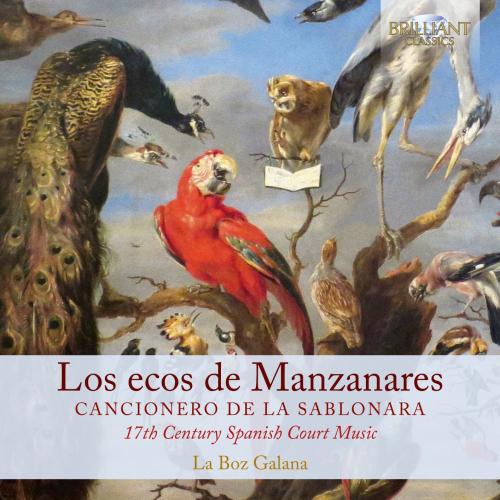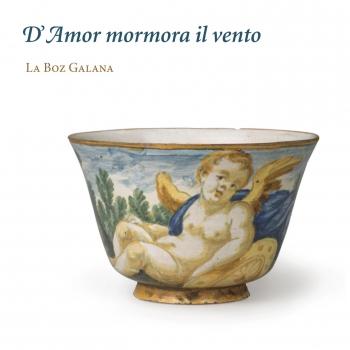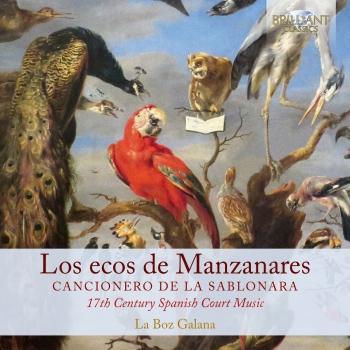
Los ecos de Manzanares: Cancionero de la sablonara La Boz Galana
Album info
Album-Release:
2020
HRA-Release:
31.01.2020
Album including Album cover Booklet (PDF)
- Gabriel Díaz (1590 - 1638):
- 1 Barquilla pobre de remos 04:32
- Diego Gómes (1550 - 1618):
- 2 En el valle del ejido 04:26
- Álvaro de los Ríos (1580 - 1623):
- 3 Sin color anda la niña 03:57
- 4 Folías 04:33
- 5 Pajarillos suaves 04:05
- Mateo Romero (1575 - 1647):
- 6 Bullicioso y claro arroyuelo 03:09
- Juan Blas de Castro (1561 - 1631):
- 7 Desde las torres del alma 03:53
- Bernardo Clavijo del Castillo (1545 - 1626):
- 8 Tiento Ileno de 2º tono 04:01
- Mateo Romero:
- 9 Ricos de galas y flores 02:50
- Miguel de Arizo (1590 - 1633):
- 10 Vistióse el prado galán 03:39
- Juan Blas de Castro:
- 11 Ya no les penso pedir 04:14
- Anonymous:
- 12 De tu vista celoso 02:13
- Manuel Rodrigues Coelho (1555 - 1635):
- 13 Susana grosada 05:42
- Joan Pujol (1912 - 1988):
- 14 Llamaban los pajarillos 02:58
- Mateo Romero:
- 15 Romerico florido 03:06
- 16 Fatigada navecilla 03:13
Info for Los ecos de Manzanares: Cancionero de la sablonara
Love songs and instrumental interludes from 17th-century Madrid in lively and beguiling, historically informed performances.
The Manzanares flows from the Sierra de Guadarrama and passes through Madrid, on its way to join the Jarama river, which in turn becomes swallowed by the mighty Tagus. On the banks of the Manzanares, the young Madrileños of the 1600s would sunbathe and drive horses into the water. The river was as characteristic of the city’s life as the theatre, the nightlife, the guitar and the folía (Spanish dance).
Under the leadership of Philip IV, Spain was a place of dreams and ambitions, with the New World just over the horizon. The king himself was a great lover of music and dance, and he cultivated a court of singers who could accompany themselves on the guitar. They were led for a period by Alvaro de los Rios (1580-1623) who attracted musicians from across the Iberian peninsula and farther afield to enhance the cosmopolitan vibrancy of Philip’s court.
The music included on this recording is representative of the transition from Renaissance polyphony to the new Baroque style: on one hand, there are madrigal-like pieces, with elaborate contrapuntal and melodic imitation, and on the other, completely homophonic compositions based on lively rhythms, dance patterns and poems of a popular nature, such as the seguidillas.
The secular songs have been taken from a little known collection, the Cancionero de la Sablonara composed for the Royal Court of Madrid during the first two decades of the 17th century. The collection features many names little known to us now, making the album full of exciting discoveries for lovers of the early Baroque. The songs are interspersed with contemporary instrumental pieces, played here by guitar, chittarone and Spanish double harp.
Founded in 2011, La Boz Galana (‘The Galant Voice’) is a Basle-based group of musicians specialising in the Renaissance and Baroque periods, drawn from across South America and France. This album marks their debut on Brilliant Classics.
The Cancionero de la Sablonara is a collection made up of 75 polyphonic songs composed for the Royal Court of Madrid during the first two decades of the 17th century. The manuscript is named after Claudio de la Sablonara, copyist and archivist of Madrid’s Royal Chapel. Today the manuscript is kept in the State Library of Bavaria, which is why it is also called the Cancionero de Múnich.
The repertoire contained in this book consists of secular polyphonic songs. These pieces represent the greatest Spanish profane vocal music of the period and were composed by some of the most brilliant musicians active in the Madrid court. Many of the texts on which they were composed were written by distinguished poets of Spain’s Golden Age, such as Lope de Vega, Luis de Góngora and Francisco de Quevedo. The style of the music is representative of the transition from Renaissance polyphony to the new Baroque style.
Performed by the Early Music group La Boz Galana, specialized in the music from the Spanish Renaissance and Baroque.
La Boz Galana
La Boz Galana
was created in 2011 by singers and instrumentalists from Colombia, Brazil, Chili and France. At the time, all were students at the prestigious Schola Cantorum Basiliensis of Basel, Switzerland.
La Boz Galana is particularly dedicated to the research and interpretation of the Renaissance and Baroque Iberian and Latino-American repertoire, with and without accompaniment. Our ensemble : two sopranos, alto, baritone and accompaniment, allows us to explore a major part of the vocal repertoire, sacred as well as secular, from the end of the 16th until the beginning of the 18th Century.
The instruments used for the accompaniment, the arpa de dos ordenes (Spanish baroque harp), the baroque guitar and the viola da gamba, are all indigenous instruments of this repertoire. Other instrumentalists and/or singers may join the ensemble depending on the needs of the program.
The name "La Boz Galana" ("the gallant voice"), uses the orthography of the 16th and 17th Centuries. It's an expression that could have appeared in poems or romances by Cervantes or Lope to describe a song beautifully sung or a text gallantly proclaimed.
La Boz Galana regularly works in collaboration with the Spanish musicologist Raùl Angulo Dìaz and the Gustavo Bueno Foundation. His first CD, with villancicos and motets by the spanish composer Matías Durango, was published in 2015 by the spanish label Lindoro.
The ensemble has performed mostly in France and Switzerland (CCR Nantes, Festival Vochora, Festival du Mont Blanc, Festival de Froville, Les Goûts Réunis, etc…)
Booklet for Los ecos de Manzanares: Cancionero de la sablonara












